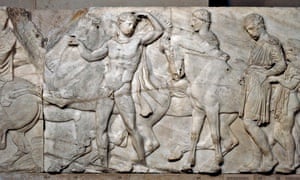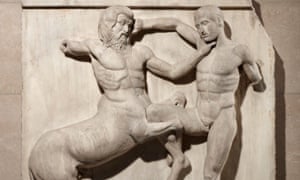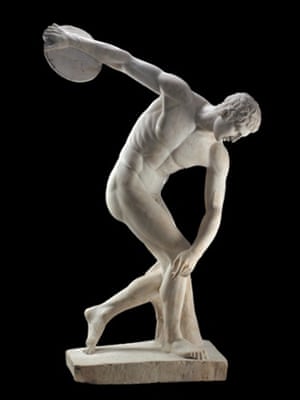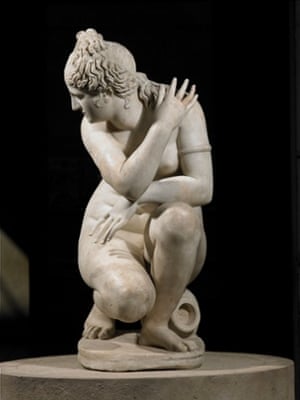Naked ambition: when the Greeks first stripped off
We are so used to nude statues their strangeness escapes us. Was this exposure of the body to do with sex, athletics, war or virtue? James Davidson visits Defining Beauty, the stunning new exhibition of the body in Greek art

T
he oddity of ancient sculpture often escapes us. A male nude, a Greek statue, has become very familiar over the past 2,500 years: it is what we expect of ancient statuary, that it show off its muscles. At times it can seem overly familiar, a bit tacky or tawdry or maybe just banal, evoking the withdrawing room of an aesthete of the 1890s, a gay sauna in the 1970s or the yard at the back of a modern garden centre alongside the blue-glazed planters and bird baths.
The Uffizi in Florence was once most famous for its collection of classical sculptures, but who now spends much time looking at them as they barge past to the Botticellis? If you find the crowds around the Hieronymus Bosches too much in the Prado, seek out the cul-de-sac where they have put the wonderful San Ildefonso statue group for some peace and quiet. Even when antique statuary does not have to compete with modern painting, it can find it hard to divert attention from the artefacts of more exotic cultures. It can be impossible to move in the Egyptian sculpture rooms of the British Museum, but I have often found myself alone with the sculptures that once decorated the mausoleum of Mausolus of Halicarnassus.

Ancient sculptures only seem happy when they have an entire institution to themselves, as in the Glyptothek in Munich, one of my favourite museums, which has in its collection the early classical sculptures of the temple of Aphaia in Aegina and the Barberini Faun, possibly the sexiest marble statue in the world.
But every now and again the strangeness of Greek bodies is brought home to us. The opening ceremony of the Athens Olympics in 2004, for instance, in which real-life models were fitted with strange high-waisted small-willied nude sculpture trousers to wear over clay-grey Lycra shorts, emphasising all too obviously, through their odd stumpiness, the way that ancient statues exceeded the norm. Or the statue of the Holy Roman Emperor Charles V of Spain in the Prado, trampling on the demon of Religious War. The statue is normally shown in full armour, but the sculptor arranged it so that the emperor could also be seen in the altogether, revealing a superb imperial torso that would not disgrace the cover of Men’s Health magazine.Ancient statues have suffered a precipitous decline in cultural value over the last 200 years, one only exceeded by that of tapestries and reliquaries. But their fate is in some ways worse. Tapestries and reliquaries are simply not looked at. Ancient statues are looked at and not seen. Like the taste of water, the sound of elevator music or the smell of air, they have become part of the landscape, lithic wallpaper, garden furniture, C major. It is as if everything that needed to be done in terms of the sculpture of the human form was achieved by 300BC.
Or, finally, the Riace bronzes: two rare examples of original classical free-standing sculptures fished from the sea under the toe of Italy in 1972 and producing gasps of wonder and astonishment ever since. Above all, they remind us that most of what we think of today as classical statues are in fact Roman copies – sometimes, in fact, garden furniture – carved in stone of bronze originals, originally modelled in wax. Somehow, these two remarkable bronzes, coming from so close to the source of the standard models but unlike anything ever seen before, manage to break away from the unseeing gaze we turn on timeless classics. Perhaps it is all the accessories, the teeth and eyelashes and eyeballs that make us look at them again, if only to make sure they are not looking at us when we look away, or maybe it is because nobody knows who they are or where they are from or who could possibly have created them.
The Greek nude is in fact a complicated and mysterious thing and one that I find it hard to get my head around despite years of study. It has something to do with nudity in practice, obviously, and Greek homosexuality, obviously, and a passion for athletics and the gymnasium (“place of undress”), obviously, and war, probably, but it is also about morality, virtue and metaphysics. One thing is for sure: Greek nudity is not simply the result of a complete lack of self-consciousness, about walking around as Nature intended.

The Greeks could see their nudity was a bit odd, and wondered how it came about. One theory was that an early competitor at the Olympics had accidentally or deliberately lost his loincloth and went on to win the 200m sprint, thanks to some aerodynamic advantage. Not to be outdone, the other competitors copied him. More likely it has something to do with primitive rituals of “stripping off” one’s childhood cloak and “running out” into the ranks of citizens at the age of 20, practices still going on in Sparta and Crete in the historical period.
Nudity was a kind of costume, an idea enhanced by the fact that much time seems to have been spent oiling oneself up and scraping oneself down. The best condiment for the body was that olive oil produced from the sacred olive trees given to Athens by Athena and awarded as prizes in the games that accompanied her birthday. The resulting salty “boy gloop” or paidikos gloios was sometimes collected and used to treat ailments and signs of ageing.In Athens, meanwhile, on Athena’s birthday at the hottest time of year, each graduating year of ephebes would streak all the way from the altar of Love in the gymnasium called “the Academy” to the Acropolis carrying torches, the laggards and the podgier ones getting slaps from the crowds as they huffed and puffed through the main city gate.
The gymnasium was criticised by both Plato and the Romans for promoting Greek homosexuality and it certainly seems to have been where much of the action took place; and not just looks and stares and love affairs but the homosex itself, mostly frottage in a standing position which they called diamerion “between the thighs”. Doubtless chemical analysis of ancient boy gloop would be found to reveal traces of sperm almost as frequently as do swabs of modern computer trackpads. The gymnasium also seems to be the setting for a unique scene on a vase in the British Museum in which a handsome ephebe climbs on to the erect penis of another ephebe sitting on a chair, while a trainer (perhaps) and a woman wait outside: Life in the Socratic Circle is how Sir John Beazley, the great pioneer of the study of Greek vase-painting, described it, tongue not entirely in cheek.

Life in the Socratic Circle has a place in the stunning new exhibition at the British Museum, Defining Beauty, but its mind is mostly on higher things. In room one we are presented with the arresting sight of three great classical nudes, one upright, one horizontal and one somewhere in between: the Spear-bearer of Polyclitus, the river god Ilissos from the Parthenon and Myron’s Discus-thrower bending right down in order to spin his discus into the far ether.
The Ilissos sculpture fitted into the narrow corners of the west pediment, the “back” of the Parthenon. Here was shown the contest for Athens between Poseidon, who tried to bribe the Athenians with a miraculous inland pool of salty water, and Athena, who offered them the olive tree. Athena won. Obviously.
Myron’s Discus-thrower is one of those “Roman copies in stone of lost Greek originals in bronze”, but actually this is a very good reproduction of what must have been a completely startling original. It is often cited as an example of balance and geometry, but the abstracted albeit beautiful classical head contrasts with the straining toes in a balance not just of weight but of realism against idealism. This is not an abstract work of art.
Myron was very famous. The man who sculpted the figure of the Ilissos is unknown. There is a tendency to link it as closely as possible to Pheidias, one of the greatest sculptors of the classical age. But the Parthenon was the biggest temple in Greece. Apart from the two huge pediments at either end it had two rows of sculpted decoration around its circumference, the metopes on the outside and “the Parthenon frieze” inside that. Meanwhile Pheidias was responsible for the artistic centrepiece of the whole programme, the gigantic statue of Athena in ivory and gold that filled the Parthenon’s interior, so huge that even the sides of the soles of her sandals were decorated with reliefs. That was probably enough to be getting on with.
Not all the Parthenon sculptures are as superb, but most of them are. Some of them may have been sculpted or directed by someone famous, maybe the same person as the man who sculpted the Riace bronzes, or maybe not. It was a collective effort like the King James Version of the Bible – one of those moments in the history of human civilisation when a medium meets its match in human creativity and genius briefly proliferates.

The exhibition is not only about huge nudes. There are some wonderful billowy draperies revealing more womanly silhouettes – again the powerful fluttering figure of winged Iris, rainbow messenger of the gods from the west pediment of the Parthenon, is the one that most astonishes. And there is a wonderful Amazon from the Capitoline Museums in Rome, examining her wounds in disbelief. There are images of corpulence, babyhood and old age. There are some of the earliest representations of black Africans in western art and a charming mirror case from Corinth showing a benign looking goat-headed Pan playing knucklebones with a curvy Aphrodite. I nearly missed a tiny matchstick geometric bronze of a man killing himself, which could be Ajax, the most famous male suicide in mythology. That would make it among the earliest mythological scenes ever discovered.
But in the last room we are back with male nudes again, a marvellous juxtaposition of the Belvedere torso, a classical masterpiece of tension and realism, and famously an inspiration for Michelangelo, and a reclining figure from the east pediment of the Parthenon, now often labelled as a young Dionysus, but almost certainly also a reflection of the constellation Orion reclining along the ridge of Mount Hymettus on the morning of Athena’s birth, an allegory of time just as the west pediment with its rivers and rainbow is an allegory of space.
When first reading about this exhibition, I had my doubts about it. There are some fabulous loans from abroad, a multi-veiled bronze dancer from New York, a lifesize bronze athlete discovered only in the 1990s in Croatia, a recliningHermaphroditus from the Borghese. But the stars of the show are undoubtedly the museum’s own masterpieces and in particular the Parthenon sculptures, and those I have seen many times before. Yet whether it is the starkly modern space, the dramatic (and revealing) lighting or just the new juxtapositions, it was like seeing them for the first time. And that in itself is quite an achievement.
• Defining Beauty opens at the British Museum, London WC1B, on 26 March and runs until 5 July. britishmuseum.org. James Davidson’s books include The Greeks and Greek Love.
沒有留言:
張貼留言